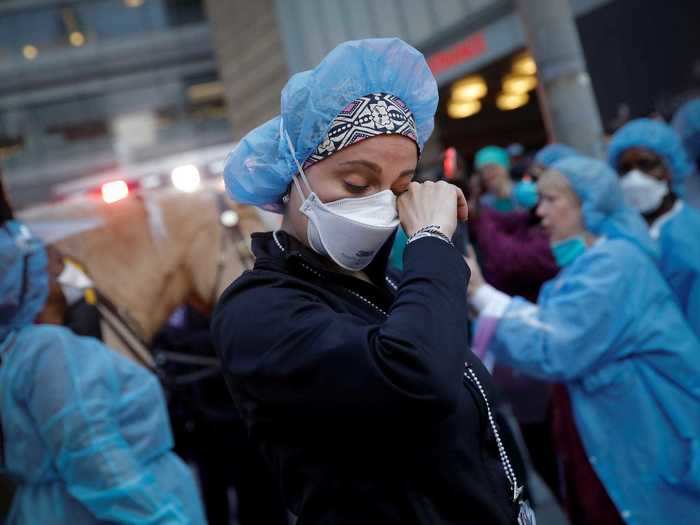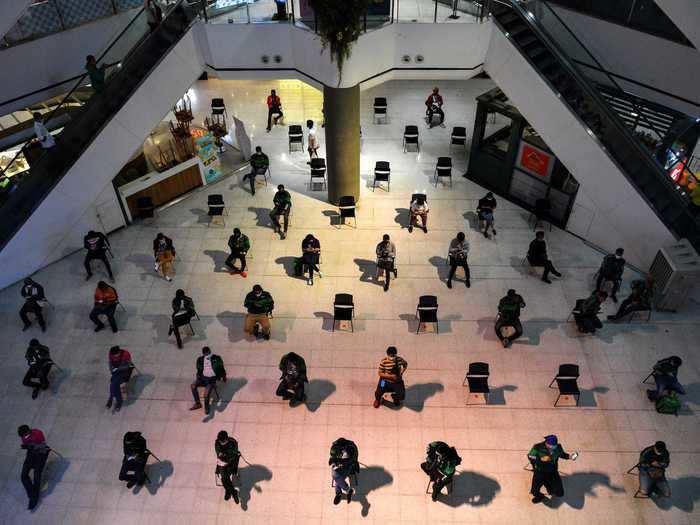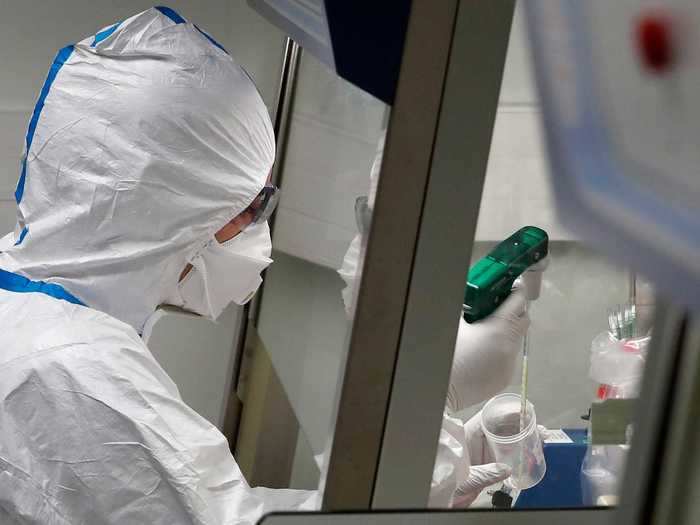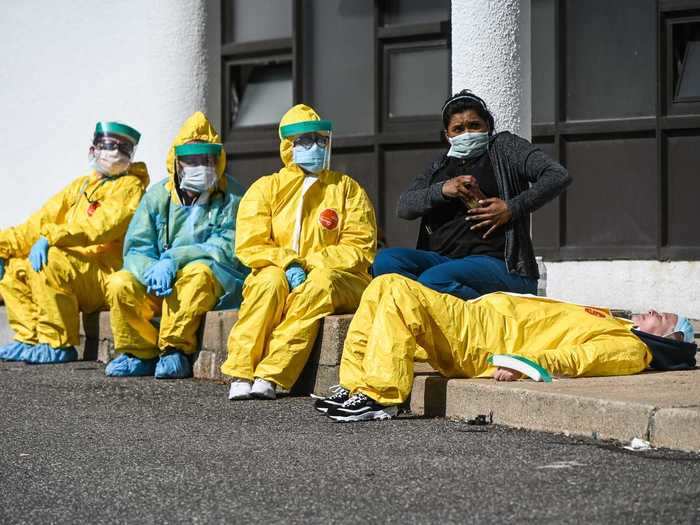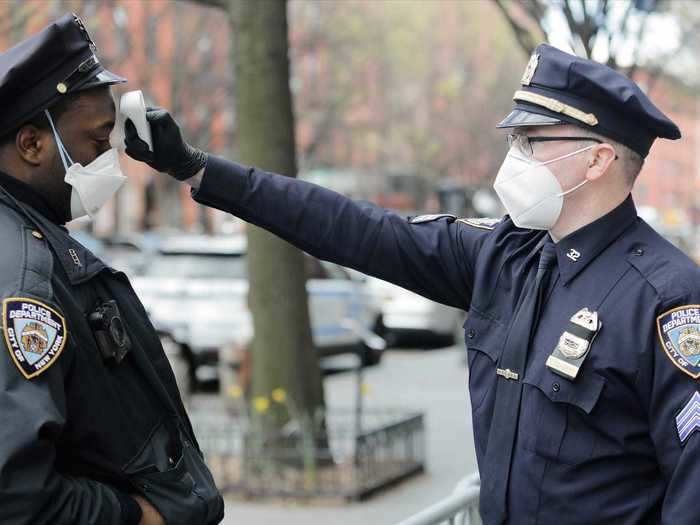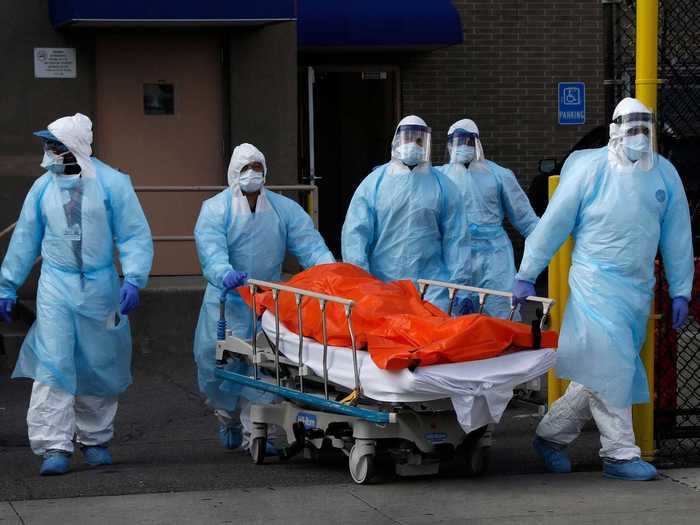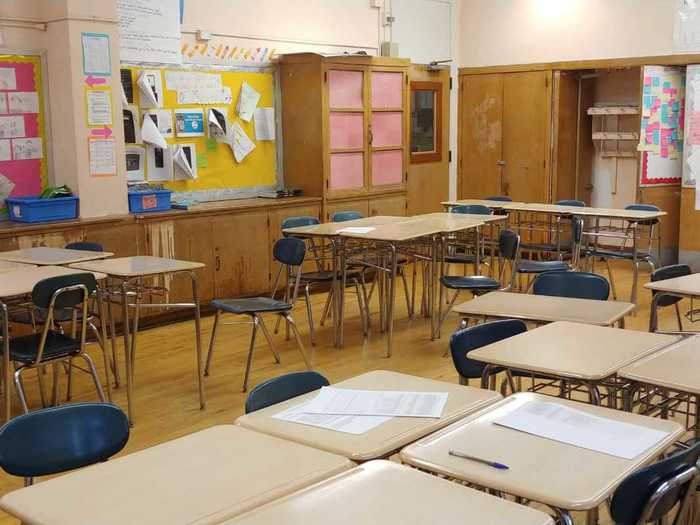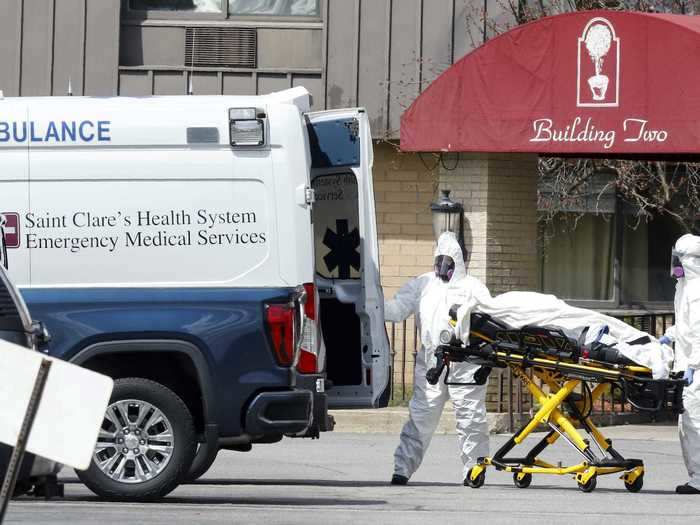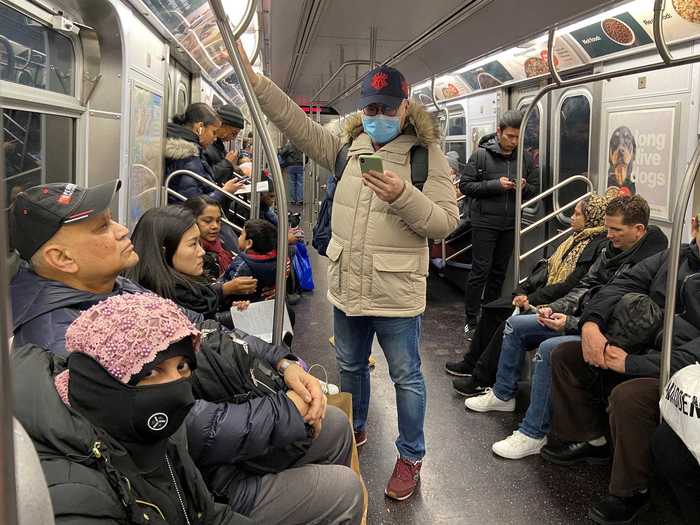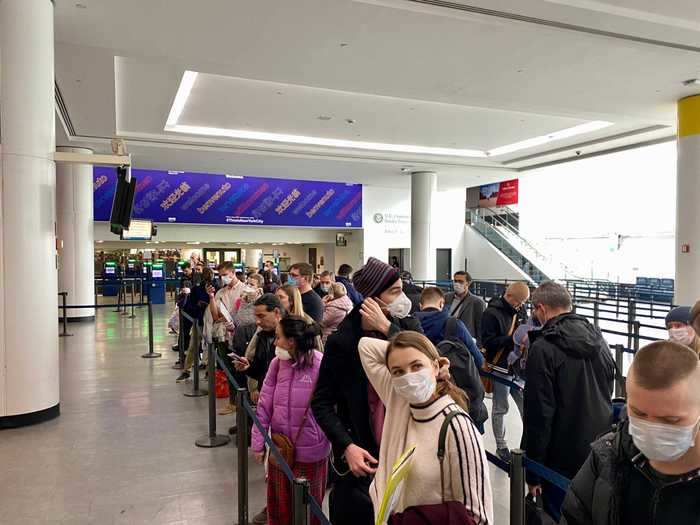Health care professionals take a break awaiting patients as they test for COVID-19 at the ProHEALTH testing site in Jericho, New York, March 24, 2020.Steve Pfost/Newsday RM via Getty Images
- In February, before anyone could know what would come of the coronavirus outbreak in the US, the Centers for Disease Control and Prevention issued an eerie set of "hypothetical" scenarios.
- At that point, there were only 60 confirmed cases in the US, but the CDC warned that more cases, person-to-person spreading, and an "overloaded healthcare system" was possible.
- Two months later, the US now has the worst outbreak in the world, with nearly 700,000 cases and at least 36,000 deaths.
- Visit Business Insider's homepage for more stories.
On February 27, the US had only 60 confirmed cases of the novel coronavirus, and zero reported deaths.
Today — just 45 days later — the country has become the epicenter of the virus in the world, with more than 640,000 cases and at least 31,000 deaths.
But Americans didn't expect it to move this fast. Just two months ago, life was largely business as usual in the US, and many didn't see the virus as much more threatening than the common flu. Even the US government dismissed early fears that the outbreak could become severe.
But experts had been warning about the impact of COVID-19 from the beginning. Towards the end of February, the CDC issued an outline of what "could" happen in the US if the virus continued to spread.
Predicting overwhelmed hospitals, school closures, and widespread transmission, the CDC's "hypotheticals" are now shockingly close to today's reality.
Read the original article on
Business Insider
So far, the coronavirus has infected at least 2.2 million people and killed 153,000 worldwide. The US has the highest case total in the world.
The US remains the hardest-hit country to date, with New York as the country's epicenter.
Though the number of patients being hospitalized in New York City is beginning to slow, experts warn that it could take multiple waves of outbreaks before we get it under control, and that the country won't be fully back to normal for quite some time.
The CDC also predicted that "Nonpharmaceutical interventions would be the most important response strategy."
This remains true, as well.
The idea of "flattening the curve" through social distancing remains the only effective strategy at reducing the spread of the coronavirus. Since we know the virus is able to spread quickly, quietly, and through multiple types of carriers, the best way to halt it is to avoid coming into contact with others.
Two medical experts have even suggested that 90% of coronavirus cases in the US could have been prevented if social distancing began much earlier, on March 2.
To protect yourself from the virus, the CDC recommends:
- Cleaning your hands often
- Avoid close-contact with those who are sick
- Staying home as much as possible
- Distance yourself from others at least 6 feet in public
- Wear cloth facial covering over your mouth and nose
- Clean and disinfect frequently touched surfaces
Amid these predictions, the CDC warned that "At this time, there is no vaccine to protect against COVID-19 and no medications approved to treat it."
That's still true.
But at least 70 vaccine are in development and three have already begun human trials. While vaccines typically take years to develop and approve, researchers around the world are working at an unprecedented speed to get an effective, safe vaccine on the market.
But even so, Fauci has said the US is still 12 to 18 months away from a vaccine, and some experts think even that's aiming too high. One biotech analyst told Business Insider's Andrew Dunn a vaccine might only be 50% likely by 2023.
To put it into perspective, even though this coronavirus is the third outbreak of its kind in the 21st century — following SARS and MERS — there are still no approved vaccines for coronaviruses.
And there are still no approved drugs that can effectively treat the coronavirus.
"Health care providers and hospitals may be overwhelmed," the CDC predicted.
One hospital worker in New York City called the situation "apocalyptic" after 13 people died in a hospital in a single day.
Others have compared the situation as responding to war, as healthcare workers face supply shortages and an overwhelming number of patients.
"We're going to war and without any ammunition," hospitalist Azmath Hussaini told Business Insider Today.
The situation has become so strained that multiple hospitals have told their workers to reuse facemasks due to the shortage. On March 13, the CDC even recommended healthcare workers wear a scarf or bandana — coverings that are not proven to be effective — if they have no surgical masks or N95 respirators.
One healthcare worker called the CDC's response to the pandemic for physicians "ludicrous."
According to an inspector general report by the Department of Health and Human Services in early April, hospitals across the country have been plagued with a lack of testing, protective gear, and shortages of supplies including thermometers and hand sanitizer, which have significantly weakened their ability to respond to the virus.
The CDC also predicted that "Other critical infrastructure, such as law enforcement, emergency medical services, and transportation industry may also be affected."
The CDC outlined the possibility that "Public health and healthcare systems may become overloaded, with elevated rates of hospitalizations and deaths."
In early April, six doctors from across the country spoke to Business Insider Today about facing a critical shortage of protective equipment and supplies to combat the coronavirus.
One hospital worker at Boston Medical Center said that "when a patient comes, you know that they're here for the long haul," and explained that patients have been staying sick in hospitals for a long period of time, without getting better.
According to data collected by the CDC, during the month of March the hospitalization rate was 4.6 people per 100,000 in the US, with 90% of patients experiencing an underlying health condition.
In mid-March the US Surgeon General called on hospitals across the country to postpone elective surgeries to make way for more room to treat coronavirus patients.
Healthcare workers have reported shortages of ventilators, respirators, masks, and other basic protective equipment across the country, and some fear that difficult decisions on who to allocate limited resources to will soon be a stark reality.
"It is a matter of when, not if. We will have to make those decisions in New York very soon, and our goal is to put that day off as far as possible," Dara Kass, an emergency medicine physician in New York City told Business Insider Today.
The agency predicted that "Schools, childcare centers, workplaces, and other places for mass gatherings may experience more absenteeism."
By mid-March businesses, schools, and workplaces began closing across the country or transitioning to remote work.
In late March, Trump extended social distancing guidelines through the end of April, encouraging Americans to avoid nonessential travel or gatherings for at least another month.
By early April, roughly 95% of Americans not working essential jobs — 42 US states — were ordered to stay at home, and only leave the house for essential activities like going to the grocery store or buying medicine.
At least a dozen states have said they will close schools for the remainder of the school year, according to the Washington Post.
The question on reopening the country has become a hot-topic, as experts warn that doing so too soon could cause another outbreak. This week the Trump administration released guidelines on reopening the country, which will be left up to the states, and based on several criteria like the implementation of widespread testing and a decrease in cases.
The CDC warned that "Widespread transmission of COVID-19 in the United States would translate into large numbers of people needing medical care at the same time."
It has.
Hospitals across the country have experienced shortages in medical supplies, testing kits, beds, and personal protective equipment for healthcare workers.
In New York — the epicenter of the outbreak in the US — thousands of patients have been hospitalized from the coronavirus, prompting the state to build makeshift hospitals in convention centers, parks, and other non-medical locations. The US Navy has sent two floating hospital ships to New York City and Los Angeles in order to relieve medical systems.
Recent CDC data showed that roughly 90% of Americans hospitalized with COVID-19 in March had underlying health conditions.
A severe lack of testing in the US has created difficulty in tracking the disease, and hospitals have had a difficult time determining the treatment course for patients who might be positive.
"It's also likely that person-to-person spread will continue to occur, including in the United States," the CDC predicted.
And they certainly weren't wrong.
The novel coronavirus has been known to spread from person-to-person contact for quite some time now, but new developments have been made in regard to coronavirus symptoms, presymptomatic and asymptomatic spreaders, and how long the virus can live on surfaces.
Researchers have determined that each person with the virus spreads it to roughly 2 to 2.5 other people, making it more contagious than the seasonal flu.
Dr. Anthony Fauci, director of the National Institute of Allergy and Infectious Disease, said between 25% and 50% of people who become infected with the coronavirus may never show symptoms — but can still spread the illness. Children, who are the least likely to get severely sick from the virus, could be significant asymptomatic carriers.
Researchers have also determined that the virus can spread when people are "presymptomatic," meaning people can spread it days before they show any symptoms at all.
We need more research, namely with antibody testing, to get a better understanding of how many people have actually had the virus.
Since the virus typically spreads from infected droplets when a person coughs or sneezes, the CDC has recommended Americans cover their face with a mask or cloth in public, and to stay at least 6 feet apart from one another when carrying out essential tasks like grocery shopping. Otherwise, nearly all Americans are still under stay-at-home orders to prevent community spread of the virus.
Toward the end of February, the CDC predicted: "It's also likely that person-to-person spread will continue to occur, including in the United States."
We've all watched the numbers rise since February.
On February 29, the US announced its first coronavirus death. By March 1, there were nearly 90,000 cases worldwide and 3,000 deaths, according the World Health Organization. At that point the virus had spread to at least 58 other countries.
Over the next two weeks, as testing efforts became more widespread, the total confirmed cases rose globally. By March 13, there were at least 132,000 confirmed cases worldwide, with more than 1,200 confirmed cases in the US.
That same day, President Donald Trump declared a national emergency, and tourist attractions like Broadway, Disney World, and museums began shutting down across the country.
By the end of the month, the US surpassed China as having the most cases in the world, with more than 82,000. At that point, one-third of the world was put under some sort of lockdown.
And at the beginning of April — just three months after the virus was first reported in China — global cases topped 1 million.
By Friday, the US had reported nearly 700,000 of the world's 2.2 million cases and 36,700 of the world's 153,000 deaths.

